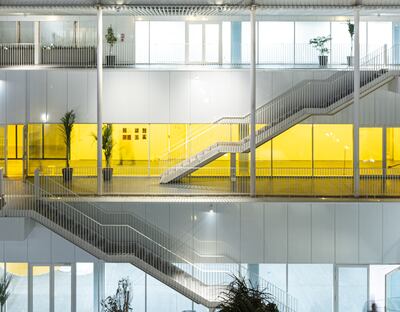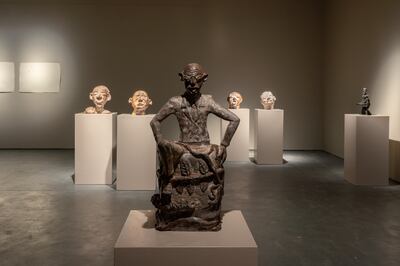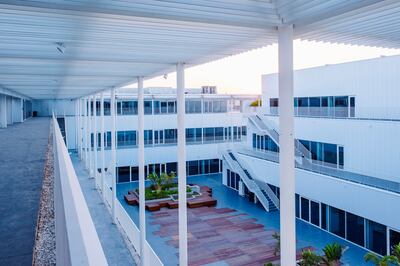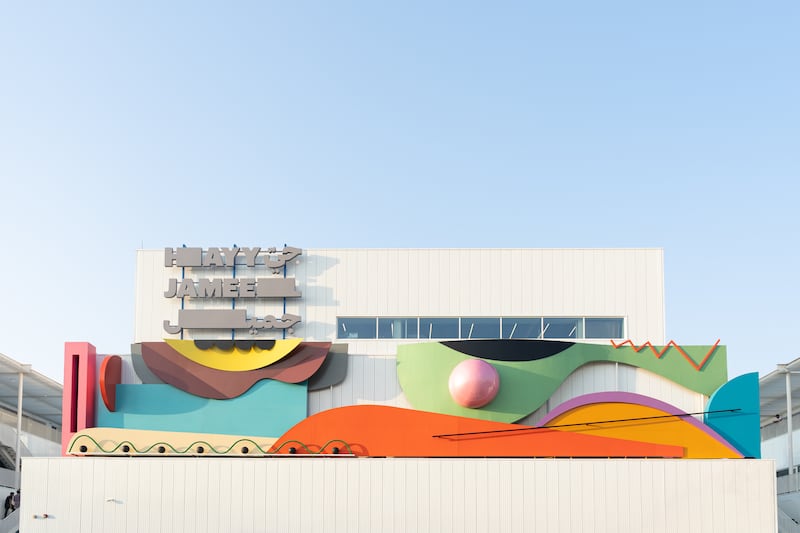In the sleepy neighbourhood of Al Mohammadiyyah in Jeddah, Hayy Jameel stands out. Taking up residence among the area’s detached villas, the arts complex, designed by architectural studio waiwai, gleams with its brightly lit white exteriors and a colourful commissioned facade by artist Nasser Almulhim.
Developed by independent organisation Art Jameel, the 17,000-square-metre centre – which has been 20 years in the making – opens its doors on Monday with a five-month inaugural programme.
Hayy stands out in other ways too – it is the city’s sole multidisciplinary arts complex that houses galleries for temporary exhibitions, art and design studios, and soon, the kingdom’s first art house cinema.
Though the idea for setting up a permanent arts space in Jeddah came about two decades ago, it was in 2014 that Art Jameel acquired the plot of land that was to become the site for Hayy.
Chosen because of its location in a residential neighbourhood, close to schools and a jazz music centre a few streets away, the centre aims to be embedded in the community’s social fabric.

While Jeddah hosts the annual 21,39 Jeddah Arts Exhibition and has a number of thriving commercial art galleries, Hayy – Arabic for neighbourhood – promises to be a site for collaboration and year-around activities centred on education and research.
Antonia Carver, director of Art Jameel, calls it a “grounded, domestic-oriented centre”, a place where Jeddah’s varied artistic and creative practices can come together to “co-exist” and “cross-pollinate”.
For its opening season, the centre, which boasts an expansive courtyard and three floors connected by maze-like staircases, is presenting a group exhibition titled Staple: What’s on your Plate?, which looks the ecological and social relationships around food, whether it is linked to trade, labour, tradition and colonialism.
Featuring 21 artists, including seven commissions, the show is a collaboration between Art Jameel and Delfina Foundation in London, with curators Rahul Gudipudi and Dani Burrows, who spent the past three years bringing it to completion.

Two other exhibitions are also on view, including Paused Mirror: The Saudi Artists, a series of wet plate portraits of artists, young and old, from the kingdom, captured by Syrian artist Osama Esid. The second is Illuminate: A Noor Riyadh Capsule, which re-adapts 11 light installations from this year’s Noor Riyadh Festival into Hayy’s galleries.
More notable is the coming Hayy Cinema, designed by Bricklab, an architectural practice rooted in Jeddah. Opening in April 2022, the audiovisual centre will include a 165-seat theatre, screening room, multimedia library and an educational space.
Its existence hints at the rapid changes the kingdom has undergone over the past few years. Originally conceived as a theatre, the space shifted its focus to film after the 35-year ban on cinemas in Saudi was lifted in 2018.
“All along we’ve been hyper-aware of the Saudi-specific context and tried to be responsive to what is needed in the kingdom, so that Hayy can fill the gaps, and be complementary to all the other incredible developments going on,” explains Fady Jameel, the chairman and founder of Art Jameel.
In developing the centre, Art Jameel was keen to keep the local population in mind, which led to an emphasis on Arabic language initiatives. “We recognise the importance of the Arabic language to the community, and so place a larger emphasis on Arabic publications and cultural production, looking at themes of relevance to the country while speaking to global urgencies,” Jameel says.

Jeddah has a long history of home-grown artist initiatives that contrast the recent top-down approach of megaprojects across Saudi, including Al Ula, which hosts the Desert X art festival, and the coming Ad Diriyah Contemporary Art Biennale. In this sense, Hayy is also unique, privately funded by the Jameel family, it has largely retained its independence in terms of programming. While this type of organisation is a rarity, founder Jameel hopes that the arrival of the permanent space will spark more initiatives like it, stating that the organisation aims to “complement the work of our government colleagues” but to “help encourage non-commercial, non-governmental foundations and enterprises to come to the fore.”
Carver agrees, seeing both private and public entities etching out their own roles in propping up the arts. “There’s a groundswell of community, as well as government support,” she adds. “We can complement everything else that is going on and add a slightly different dimension in other to build up the ecology together,” she explains.
Even as the Saudi government goes full-throttle on its arts and culture drive, particularly as part of its Vision 2030 mandate, the foundations for longevity and sustainability need a kind of strengthening that unfolds on a smaller, quieter scale.
This is perhaps the role in which Hayy Jameel is best suited. Jameel Arts Centre, its output in Dubai, for example, started out as a project space in Alserkal Avenue for many years before opening in the neighbourhood of Al Jaddaf in 2018. While the Dubai space may be more global in its selection of artists and shows, Hayy intends to continue the Jeddah art scene’s more home-grown approach.
“We’re mindful of that history and the ways in which artists have always had that community here,” Carver says. “The whole idea is that we work together in Jeddah and across Saudi to build infrastructure from the ground up.”
This translates to programmes such as Hayy Residents, where the centre has invited some local “partner-tenants” to move into the complex as a way to support creative entrepreneurship. Starting in January, the first round of residents include Athr, which will keep its art gallery space in the city, but will develop new initiatives at Hayy; AlComedy Club; design studios Al Mohtaraf and Riwaq Dahr; Aysh Academy, which will develop a bakery; and concept boutique Homegrown.
A number of studios will also be available on the top floor of the centre for artists to use. In addition, Hayy Learning will serve as an educational platform that will offer courses that can stretch from four months to two years.
“There’s a craving for slow thinking, slow development. [We’re] thinking about the kinds of infrastructure and skills that artists need for resilience in the global art world,” Carver says, noting the centre’s emphasis on supporting research and artistic process.
“It’s exciting to launch, but it’s more exciting to do what’s next,” she adds. Hayy’s transformative potential will reveal itself in the coming years. In a place such as Saudi, where change seems swift, the organisation’s responsiveness will continue to be put to the test.






